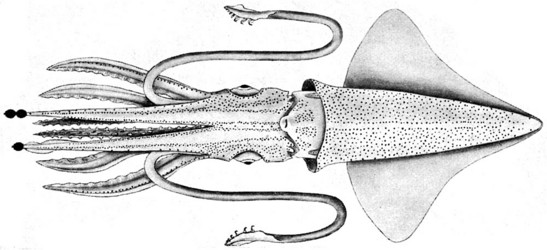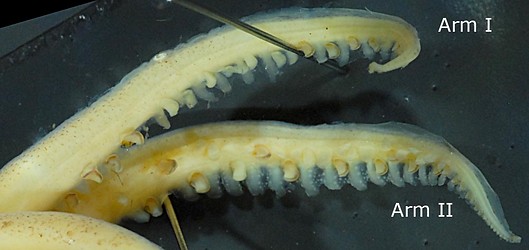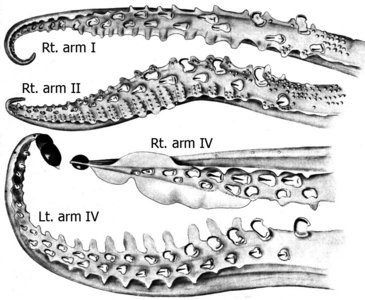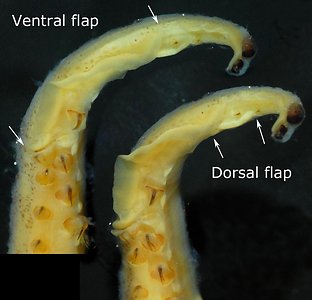Abraliopsis gilchristi
Richard E. Young and Kotaro TsuchiyaIntroduction
A. gilchristi is one of the most easily recognized species of Abraliopsis. Males reach at least 39 mm ML and, presumably, females reach a bit larger size. It occupies temperate waters of the southern hemisphere.


Figure. Ventral view of Abraliopsis gilchristi.Drawing from Voss (1967, Pl. Ia).
Brief diagnosis:
A species of Abraliopsis with ...
- 4 series of photophores on central, ventral surface of head.
- with scattered red photophores on mantle.
Characteristics
- Tentacle clubs
- Largest hooks of ventral series on manus about 3X height of dorsal counterparts.
- Carpal flap and aboral keel, large.
- Arms
- Arms I-IV with 17 - 28 hooks; only arms I-III with distal suckers.
- Arms IV relatively short; ALI IV = 40-65.
- Females: Trabeculate protective membranes virtually absent from dorsal margins of arms I-III and absent from both margins of arms IV; trabeculate protective membranes well developed in ventral margins of arms I-III. Tubercules absent from trabeculae and arms.
- Hectocotylus and male sexual dimorphism
- Hectocotylus with long ventral flap and shorter, offset dorsal flap; Modified portion with armature.
- Hectocotylus hooks about equal size on both margins proximally; in mid-arm hooks of ventral margin abruptly smaller to end of arm.
- Spatulate trabeculae on the protective membrane of left arm IV; proximally, hooks are larger than their ventral counterparts.
- Arms I: dorsal border with small lappets; ventral border with large membrane bearing long, broad trabeculae; tubercules present on arm base.
- Arms II: dorsal margin with short trabeculae bearing tubercules but membrane nearly absent; ventral margin with enlarged membrane and long, flat trabeculae, both trabeculae and membrane with tubercules.
- Arms III: dorsal margin with lappets only; ventral margin with narrow trabeculae and deep membrane but without papillae.
 Click on an image to view larger version & data in a new window
Click on an image to view larger version & data in a new window
Figure. Dorso-oral views of arms I and II of A. gilchristi, Male, 32 mm ML. Photographs by R. Young.
 Click on an image to view larger version & data in a new window
Click on an image to view larger version & data in a new window

Figure. Left - Oral view of some arms of A. gilchristi, including the hectocotylized right arm IV. Drawing from Voss (1967, Pl. IIIa-d). Right - Two slightly different oral views of the same modified end of the hectocotylus showing the long, ventral flap and the short dorsal flap.
- Photophores
- Ocular photophores: 5 photophores with end members about 2X larger than middle member.
- Integumental photophores: Ventral-most head with 4 series of photophores. Mantle with scattered photophores.
 Click on an image to view larger version & data in a new window
Click on an image to view larger version & data in a new window

Figure. Ventral views of the integumental photophores of A. gilchristi, female, 32 mm ML, South Atlantic. Left - Photograph of the preserved squid. Right - Outline drawing with all integumental photophores represented by colored dots. Red dots - Complex photophores. Blue dots - Non-complex photophores. Images by R. Young.
Detailed information on the integumental photophores can be found here.
- Ocular photophores: 5 photophores with end members about 2X larger than middle member.
- Measurements and counts
Table data taken from Voss (1967).Sex
Male
Male
Female
Mantle length
34
37.5
38
Head width index
29.4
32.3
-
Fin length index
82.4
82.7
81.6
Fin width index
91.2
89.6
81.6
Arm Length index:
I
61.8 53.3
43.4
II
50
53.3
50
III
60.3
53.3
52.6
IV
76.5
74.6
76.3
No. arm hooks:
I
17
17
17
II
17
19
20
III
21
20
19
IV
23
28
23+
Club length index (R/L)
- - 26.3
Comments.
Most of the above description is from Voss (1967).
Note that the arm features of the male are very similar to those of the subgenus Pfefferiteuthis. Also note that the scattered arrangement of red photophores on the mantle and some areas of the head are very similar to arrangements in members of the subgenus Abraliopsis.
See Abraliopsis (Micrabralia) page for comparisons among all species of the subgenus.
Life history
Abundance
Alexeyev (1994) reported the highest abundance and frequency of this species between 40° - 45° S in central southern Pacific.Maturation
In the central South Pacific, the squids caught in April of 1987 were all immature. In July, stage I of maturity was already absent, while individuals at III and IV stages made up 86% of females and 87% of males. In September, the majority of squids were mature or spent (Alexeyev, 1994).Feeding habitat
This species feeds on crustaceans, mainly copepods, and to a lesser extent on euphausiids and hyperiids (Alexeyev, 1994).Distribution
Geographical Distribution
A. gilchristi is distributed in circum-southern temperate waters between 20° - 45° S, but is not known from the southern coast of Australia (Riddell, 1985; Alexeyev, 1994). This species is abundant at the southern border of the Subantarctic frontal zone in the central South Pacific (Alexeyev, 1994) Alexeyev classified this as "peripheral notalian species"
References
Alexeyev, D.O. 1994. New data on the distribution and biology of squids from the southern Pacific. Ruthenica, 4:151-166.
Riddell, D.J. 1985. The Enoploteuthidae (Cephalopoda: Oegopsida) of the New Zealand region. Fisheries Reserch Bulletin (NZ), 27:1-52.
Voss, G.L. 1967. Some bathypelagic cephalopods from South African waters. Annals of the South African Museum, 50(5):61-88
Title Illustrations

| Scientific Name | Abraliopsis gilchristi |
|---|---|
| Specimen Condition | Preserved |
| Identified By | R. E. Young |
| Sex | Female |
| View | Ventral |
| Size | 32 mm ML |
| Collection | USNM 884908 |
| Image Use |
 This media file is licensed under the Creative Commons Attribution License - Version 3.0. This media file is licensed under the Creative Commons Attribution License - Version 3.0.
|
| Copyright |
©

|
About This Page

University of Hawaii, Honolulu, HI, USA

Tokyo University of Fisheries, Tokyo, Japan
Correspondence regarding this page should be directed to Richard E. Young at
Page copyright © 2016 and
 Page: Tree of Life
Abraliopsis gilchristi .
Authored by
Richard E. Young and Kotaro Tsuchiya.
The TEXT of this page is licensed under the
Creative Commons Attribution-NonCommercial License - Version 3.0. Note that images and other media
featured on this page are each governed by their own license, and they may or may not be available
for reuse. Click on an image or a media link to access the media data window, which provides the
relevant licensing information. For the general terms and conditions of ToL material reuse and
redistribution, please see the Tree of Life Copyright
Policies.
Page: Tree of Life
Abraliopsis gilchristi .
Authored by
Richard E. Young and Kotaro Tsuchiya.
The TEXT of this page is licensed under the
Creative Commons Attribution-NonCommercial License - Version 3.0. Note that images and other media
featured on this page are each governed by their own license, and they may or may not be available
for reuse. Click on an image or a media link to access the media data window, which provides the
relevant licensing information. For the general terms and conditions of ToL material reuse and
redistribution, please see the Tree of Life Copyright
Policies.
- Content changed 03 November 2013
Citing this page:
Young, Richard E. and Kotaro Tsuchiya. 2013. Abraliopsis gilchristi . Version 03 November 2013 (under construction). http://tolweb.org/Abraliopsis_gilchristi/19687/2013.11.03 in The Tree of Life Web Project, http://tolweb.org/







 Go to quick links
Go to quick search
Go to navigation for this section of the ToL site
Go to detailed links for the ToL site
Go to quick links
Go to quick search
Go to navigation for this section of the ToL site
Go to detailed links for the ToL site